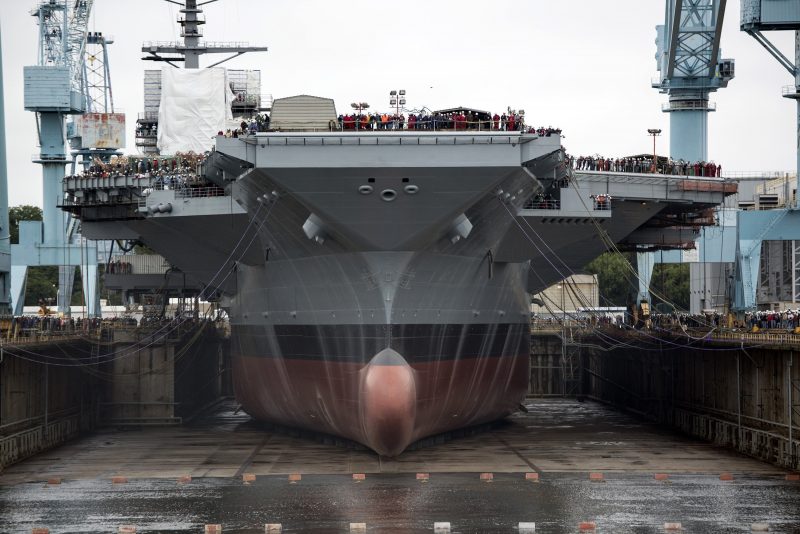The $13-billion USS Gerald R. Ford is already two years behind schedule, and the U.S. Navy’s newest aircraft carrier is facing more delays after the Pentagon’s top weapons tester concluded the ship is still not ready for combat despite expectations it would be delivered to the fleet this September.
According to a June 28 memo obtained by CNN, Michael Gilmore, the Defense Department’s director of operational test and evaluation, said the most expensive warship in history continues to struggle launching and recovering aircraft, moving onboard munitions, conducting air traffic control and with ship self-defense.
“These four systems affect major areas of flight operations,” Gilmore wrote in his report to Pentagon and Navy weapons buyers Frank Kendall and Sean Stackley. “Unless these issues are resolved … they will significantly limit CVN-78’s ability to conduct combat operations.”
Fixing these problems would likely require redesigning the carrier’s aircraft launch and recovery systems, according to Gilmore, a process that could result in another delay for a ship that was expected to join the fleet in September 2014.
The Navy has operated 10 carriers since the retirement of the USS Enterprise in 2012.
Commanders said delays to the USS Gerald R. Ford have resulted in extended deployments for the operational carriers in order for the Navy to meet its commitments around the world, placing additional stress on sailors and crew members.
The report comes just days after the Navy announced the Ford will not be delivered before November 2016 due to unspecified testing issues, walking back testimony from April in which Stackley told Congress the Ford would be ready by September. It was first reported on by Bloomberg.
Now that delivery date could be pushed to 2017, according to the Navy.
“Electromagnetic Aircraft Launch System testing was successfully completed in May 2016 and testing of the Dual Band Radar, Advanced Weapons Elevator are projected to complete in time to support upcoming sea trials and first aircraft operations scheduled for early next year,” a Navy official told CNN.
Sen. John McCain, chairman of the Senate Armed Services Committee, slammed the latest delay as “unacceptable” and “entirely avoidable” in a statement earlier this month.
“The Ford-class program is a case study in why our acquisition system must be reformed — unrealistic business cases, poor cost estimates, new systems rushed to production, concurrent design and construction, and problems testing systems to demonstrate promised capability,” McCain said.
The USS Gerald Ford is the first of three Ford-class carriers ordered by the Navy with combined cost expected close to $42 billion.
“After more than $2.3 billion in cost overruns have increased its cost to nearly $13 billion, the taxpayers deserve to know when CVN-78 will actually be delivered, how much developmental risk remains in the program, if cost overruns will continue, and who is being held accountable,” he added.
But officials from both the Navy and Department of Defense said the issues keeping the 1,100- foot supercarrier from active duty are the result of decisions made when the Pentagon committed to building the advanced ship in 2008.
“The decision to proceed with these three systems was made many years ago, prior to their maturation, when transformational approaches to acquisition were a DOD policy,” said Mark Wright, a Defense Department spokesman. “This report from Dr. Gilmore clarifies concerns he had previously raised on this program.”
As the first new carrier design in 40 years, the USS Gerald R. Ford incorporates new technology and operational systems that will allow it to have a higher aircraft launch and recovery rate, reduced manning, and improved survivability against projected threats.
But choosing to integrate and test developmental systems “compounded the inherent challenges of a first-in-class design,” and significantly contributed the program’s delays, according to a statement from the Navy.
A comprehensive test program was developed to address the integration of these technologies through which “steady progress is being made to retire technical issues,” the Navy said.
To date, construction on the Ford is 98 percent complete with 88 percent of the test program finished.
Despite delays to the USS Gerald R. Ford’s delivery, the Navy says that the Ford-class carriers will yield a $4 billion reduction per ship cost as compared to its predecessor, the Nimitz Class.
The next carrier in the Ford class, the USS John F. Kennedy (CVN 79), is scheduled to launch in 2020. That ship was 18% percent complete as of March.
The third Ford-class carrier, the USS Enterprise (CVN 80), is set to begin construction in 2018.
Including the new carriers, the Navy hopes to spend $81.3 billion to build 38 new warships, including the first replacement for the aging Ohio-class ballistic missile submarines, nine Virginia-class attack submarines, 10 Arleigh Burke-class destroyers and smaller numbers of other surface ships.
The goal of the building plan is to have a Navy battle force of 308 ships by 2021, according to Stackley’s testimony in April.
